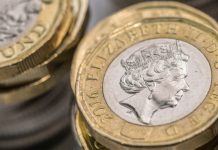The pound soared to just shy of $1.43 against the US dollar on Friday, before pulling back below $1.4250 into the close. The pound traded higher against the US dollar for five straight sessions last week, pushing it towards one of the highest levels of this year.
| What do these figures mean? |
|---|
|
When measuring the value of a pair of currencies, one set equals 1 unit and the other shows the current equivalent. As the market moves, the amount will vary from minute to minute. For example, it could be written: 1 GBP = 1.28934 USD Here, £1 is equivalent to approximately $1.29. This specifically measures the pound’s worth against the dollar. If the US dollar amount increases in this pairing, it’s positive for the pound. Or, if you were looking at it the other way around: 1 USD = 0.77786 GBP In this example, $1 is equivalent to approximately £0.78. This measures the US dollar’s worth versus the British pound. If the sterling number gets larger, it’s good news for the dollar. |
The pound appreciated 15 versus the dollar over the last week as hopes for an EU trade deal increased. U.K. Brexit Secretary David Davis said that he believed the probability of no deal being achieved was very small. This boosted the pound as market participants consider a hard Brexit is less likely.
| Why is a “soft” Brexit better for sterling than a “hard” Brexit? |
|---|
| A soft Brexit implies anything less than UK’s complete withdrawal from the EU. For example, it could mean the UK retains some form of membership to the European Union single market in exchange for some free movement of people, i.e. immigration. This is considered more positive than a “hard” Brexit, which is a full severance from the EU. The reason “soft” is considered more pound-friendly is because the economic impact would be lower. If there is less negative impact on the economy, foreign investors will continue to invest in the UK. As investment requires local currency, this increased demand for the pound then boosts its value. |
The pound was also supported by increased hopes of an interest rate rise in May. Investor optimism grew over a rate hike after Bank of England policy maker Ian McCafferty said that the central bank shouldn’t delay raising rates.
| Why do raised interest rates boost a currency’s value? |
|---|
| Interest rates are key to understanding exchange rate movements. Those who have large sums of money to invest want the highest return on their investments. Higher interest rate environments tend to offer higher yields. So, if the interest rate or at least the interest rate expectation of a country is relatively higher compared to another, then it attracts more foreign capital investment. Large corporations and investors need local currency to invest. More local currency used then boosts the demand of that currency, pushing the value higher. |
This week investor attention will shift back to the U.K. economic calendar. Analysts are expecting Inflation data on Tuesday and wages data on Wednesday to be highlights this week. February’s inflation level finally showed showed signs of easing lower after five months of being over 3%. Wages are also climbing higher, reducing the squeeze on the consumer. Market participants will be keen to see these patterns continue. The UK economy is very dependant on the consumer spending, so any relief in pressure on the consumer could help boost the service sector and therefore the economy.
Geopolitics & Data To Drive The Dollar
The dollar finished the previous week on the back foot. Despite trade war fears with China dying down, increasing political tension with Russia over Syria, weighed on sentiment for the dollar. Analysts are expecting the dollar to be under the spotlight as market opens following Western air strikes against targets in Syria over the weekend. Given the US involvement in the air strikes the dollar could be less attractive than other safe haven currencies.
US Retail Sales could provide a welcomed distraction for dollar traders and could potential offer a rallying point for the dollar, given that forecast point to a solid increase on the month. A strong reading would provide reassurance to investor; however, a soft number could hit confidence even if it is unlikely to change the Fed’s outlook.
|
This article was initially published on TransferWise.com from the same author. The content at Currency Live is the sole opinion of the authors and in no way reflects the views of TransferWise Inc. |





